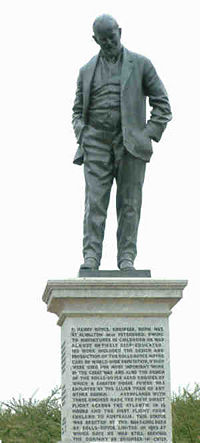Sir Henry Royce
Sir Henry Royce (March 27, 1863 - April 22, 1933) was a pioneering car manufacturer, who with Charles Stewart Rolls founded the Rolls-Royce company.
Frederick Henry Royce was born in Alwalton, Huntingdonshire, near Peterborough, the son of James and Mary Royce (maiden name King) and was the youngest of their five children. His family ran a flour mill which they leased from the Ecclesiastical Commissioners but the business failed and the family moved to London. His father died in 1872 and Royce had to go out to work selling newspapers and delivering telegrams, having had only one year of formal schooling. In 1878 he started an apprenticeship with the Great Northern Railway company at its works in Peterborough thanks to the financial help of an aunt. After three years the money ran out and, after a short time with a tool making company in Leeds, he returned to London and joined the Electric Light and Power Company. He moved to their Liverpool office in 1882[1] working on street and theatre lighting. In 1884 with £20 of savings he entered a partnership with Ernest Claremont, a friend who contributed £50, and they started a business making domestic electric fittings in a workshop in Cooke Street, Hulme, Manchester called F H Royce and Company. In 1894 they started making dynamos and electric cranes and F.H. Royce & Company was registered as a limited liability company. The company was re-registered in 1899 as Royce Ltd[1] with a public share flotation and a further factory opened in Trafford Park, Manchester.
With his fascination for all things mechanical he became interested in motor cars and bought first, in 1901, a small De Dion and in 1902 or 1903 a 1901 model two cylinder Decauville[1]. This did not meet his high standards and so he first improved it and then decided to manufacture a car of his own which he did in a corner of the workshop in 1904. Two more cars were made. Of the three, which were called Royces and had two cylinder engines, one was given to Ernest Claremont and the other sold to one of the other directors, Henry Edmunds[1]. Edmunds was a friend of Charles Rolls who had a car showroom in London selling imported models and showed him his car and arranged the historic meeting between Rolls and Royce at the Midland Hotel Manchester. Rolls was impressed and agreed to take all the cars Royce could make provided they had at least four cylinders and were called Rolls-Royce. The first Rolls-Royce car was made in December 1904 and in 1906 they joined forces to become Rolls-Royce Ltd. Royce & Company remained in business as a separate company making cranes until 1932 when it was bought by Herbert Morris of Loughborough. The last Royce designed crane was built in 1964[1].
He had always worked hard and was renowned for never eating proper meals which resulted in him being taken ill first in 1902 and again in 1911. He had a house built at Le Canadel in the south of France and a further home at Crowborough, later moving to West Wittering, both in East Sussex, England but his health deteriorated further. He had a major operation in London in 1912 and was given only a few months to live by the doctors. In spite of this he returned to work but was prevented from visiting the factory, which had moved to larger premises, fitted out to detailed plans by Royce, in Derby in 1908. He insisted on checking all new designs and engineers and draughtsmen had to take the drawings to be personally checked by him, a daunting prospect with his well known perfectionism. He also continued to do design work himself, particularly on the aircraft engines that the company was starting to make, and it was for this that he was named Baronet Royce of Seaton (Rutland) on June 26, 1930.
Henry Royce married Minnie Punt in 1893 and they set up home together in Chorlton-cum-Hardy, Manchester, and were joined by Royce's mother who lived nearby until her death in 1904 and Minnie's niece Violet. The Royces moved to a newly built house in Knutsford, Cheshire in 1898. Henry Royce and Minnie separated in 1912. After he was taken ill Royce was looked after by a nurse, Ethel Aubin.
In 1962 a memorial window dedicated to his memory was unveiled in Westminster Abbey the only time an engineer has been honoured in this way.
ReferencesISBN links support NWE through referral fees
Bastow, Donald. 1989. Henry Royce, mechanic. Derby, England: Rolls-Royce Heritage Trust. ISBN: 9780951171042
External links
bs:Frederick Henry Royce cs:Henry Royce de:Henry Royce fr:Henri Royce no:Henry Royce simple:Henry Royce sk:Henry Royce uk:Ройс Генрі
